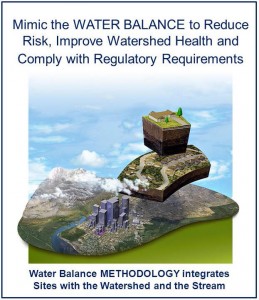Rainwater Management in Seattle: Mayor’s Executive Order directs a coordinated approach to increased use of natural drainage systems
The Goal: Six-Fold Increase in Volume Diversion into Ground by 2025
In March 2013, Seattle Mayor Mike McGinn announced a new goal for managing Seattle’s rainwater runoff by detailing a new effort where polluted runoff will be increasingly managed using natural drainage systems rather than traditional pipe and tank systems.
A video of the announcement is posted on the City’s Seatlle Channel. To view it, click here.
Increased Use of Green Infrastructure
The Mayor’s executive order—among the first of its kind in the nation— directs City departments to develop a coordinated approach to significantly increase the use of natural drainage systems to slow and clean polluted waters by filtering the water through vegetation and soil, much like a forest ecosystem does.
 “Whenever possible, we should be looking for ways to better manage our stormwater with natural processes and leveraging our drainage investments,” the Mayor said, announcing a new goal to manage 700 million US gallons of rainwater runoff annually with green stormwater infrastructure, by the year 2025. “Seattle residents and businesses care about the environment. And that’s why we are inviting the whole community to join us in this effort.”
“Whenever possible, we should be looking for ways to better manage our stormwater with natural processes and leveraging our drainage investments,” the Mayor said, announcing a new goal to manage 700 million US gallons of rainwater runoff annually with green stormwater infrastructure, by the year 2025. “Seattle residents and businesses care about the environment. And that’s why we are inviting the whole community to join us in this effort.”
 “So now the city has set an ambitious goal: treating 1,000 gallons of stormwater per resident with green infrastructure by the year 2025. To visualize that, they said what’s needed is about six square feet of raingardens, per person,” reported Bellamy Pailthorp, environmental reporter with radio station KPLU.
“So now the city has set an ambitious goal: treating 1,000 gallons of stormwater per resident with green infrastructure by the year 2025. To visualize that, they said what’s needed is about six square feet of raingardens, per person,” reported Bellamy Pailthorp, environmental reporter with radio station KPLU.
 “Seattle has long been a leader in the deployment of green infrastructure,” said Karen Hobbs, Senior Policy Analyst for the Natural Resources Defense Council. “The Mayor’s announcement not only lays a strong foundation for the city’s ongoing infrastructure planning efforts, but also will be a valuable example for other cities.”
“Seattle has long been a leader in the deployment of green infrastructure,” said Karen Hobbs, Senior Policy Analyst for the Natural Resources Defense Council. “The Mayor’s announcement not only lays a strong foundation for the city’s ongoing infrastructure planning efforts, but also will be a valuable example for other cities.”
Measures to Achieve the Green Infrastructure Goal
“The Executive Order is effective immediately. However, the mayor also introduced a City Council Resolution. That measure will go to a committee for review, possible revision, possible hearing, and then a vote/ratification later this spring. So, we have the Executive branch pronouncement in motion immediately, and the Legislative branch action is pending,” explains Pam Emerson, a professional engineer in the City’s Office of Sustainability and Environment. She is the Policy Advisor for Green Infrastructure Planning.
The “green stormwater goal” will be achieved through a combination of city-led projects on public land, “code-triggered private sector investments” and voluntary actions on private property.
Pam Emerson said “code-triggered” refers to existing requirements. Any new single-family residential project that goes through a stormwater code review must implement green stormwater measures “to the maximum extent feasible,” she said.
Other projects that already are required to do this are those with 7,000 square feet or more of “land-disturbing activity,” or with 2,000 square feet of impervious surface.
Emerson said it is possible that code requirements will change between now and 2025, when the goal is to manage 700 million US gallons of stormwater with green infrastructure.
Today, a little more than 100 million US gallons of stormwater is filtered through rain gardens, green roofs and swales.
To Learn More:
To read the complete announcement by the City on March 6, click on Setting a new goal for Seattle’s stormwater management
The View from British Columbia
“Viewed in the context of the Salish Sea which British Columbia shares with Washington State, the Executive Order by Mayor McGinn of Seattle is a timely attention-grabber for communities on both sides of the Canada-USA border. Mayor McGinn’s action reminds us that the ecological health  of urban watersheds depends in large part on watershed-scale implementation of green infrastructure practices. A defining goal of a watershed / landscape-based approach to community development is to mimic the Water Balance,” observes Kim Stephens, Executive Director of the Partnership for Water Sustainability in British Columbia.
of urban watersheds depends in large part on watershed-scale implementation of green infrastructure practices. A defining goal of a watershed / landscape-based approach to community development is to mimic the Water Balance,” observes Kim Stephens, Executive Director of the Partnership for Water Sustainability in British Columbia.
“Our system of government is different to that in Washington State. There is no equivalent of a Mayor’s Executive Order in BC. Nevertheless, any mayor can be a ‘green infrastructure champion’ and lead change in his or her community. From a BC perspective, what has caught our attention is that Mayor McGinn is clearly a champion. He has made green infrastructure a political priority. That’s the story! As a result, he is a beacon for all mayors and councils in the ‘Salish Sea watershed’ who are motivated to move from awareness of green infrastructure to action on the ground.”
The Water Balance Goal
 “The goal in mimicking the Water Balance is to protect stream health by protecting ‘hydrogic function’. We have the science-based understanding to accomplish this. We have the methodology and tools necessary to integrate actions at the site scale with desired outcomes at the watershed and stream scales. After development or redevelopment, the desired outcome is that each site will function as it did before, or better! The Water Balance goal can be achieved,” continues Kim Stephens.
“The goal in mimicking the Water Balance is to protect stream health by protecting ‘hydrogic function’. We have the science-based understanding to accomplish this. We have the methodology and tools necessary to integrate actions at the site scale with desired outcomes at the watershed and stream scales. After development or redevelopment, the desired outcome is that each site will function as it did before, or better! The Water Balance goal can be achieved,” continues Kim Stephens.
Regulation and Education: Achieving a Balance
“Historically, the Province has enabled local governments by providing policy and legal tools in response to requests from local government. Hence, governments at both levels are striving for appropriate and effective balancing of regulation and education to achieve outcome-based visions for protection and/or restoration of Watershed Health. It is a top-down and bottom-up approach,” explains Kim Stephens.
“As the implementation arm for the Living Water Smart and Green Communities initiatives in the local government setting, the Partnership’s areas of responsibility are talent development and outreach. We are integrators. We play a bridging role between theProvince, local government and community.”
 “Regulatory drivers certainly help make things happen. Yet for changes in land use planning and infrastructure engineering practices to be truly effective over the long-term in creating a legacy, all the players must share a vision of a future watershed condition. Also, good examples inform policy. Local governments learn best from those who are leading by example.”
“Regulatory drivers certainly help make things happen. Yet for changes in land use planning and infrastructure engineering practices to be truly effective over the long-term in creating a legacy, all the players must share a vision of a future watershed condition. Also, good examples inform policy. Local governments learn best from those who are leading by example.”
Inter-Regional Education Initiative
“Because we are placing emphasis on developing talent in the local government setting, the Partnership is spearheading an Inter-Regional Education Initiative on ‘Rainwater Management in a Watershed Sustainability Context’. A guiding principle is that program elements will align with local government mandates, priorities and internal work plans. Through sharing, a program goal is to leverage more with the same resources,” continues Kim Stephens.
“In 2013, the Partnership is facilitating an inter-regional collaborative process that will bring together local government representatives from the Metro Vancouver region and four largest Vancouver Island regional districts, as well as representatives from two regional offices of the Ministry of Environment. The desired outcome is inter-regional consensus on a performance monitoring framework that can be used to adjust actions and inform land use planning that maintains healthy streams in the Georgia Basin part of the Salish Sea watershed.” To learn more, click here.
“Everyone needs to agree on expectations and how all the players will work together, and after that each region and each community can reach its goals in its own way,” concludes Kim Stephens.
To Learn More:
In both Canada and the United States, there is a growing green infrastructure movement. This reflects a heightened public awareness of the need to build our communities differently. Also, land use and infrastructure professionals increasingly appreciate that effective green infrastructure is at the heart of responsible rainwater management.
To read an article published by Stormwater Magazine in November 2011, click on Rainwater Management in a Watershed Context – What’s the Goal?




